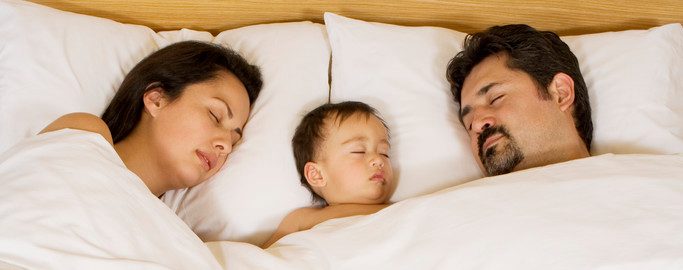Can You Sleep With Your Baby?

Sleeping in your bed with your baby is becoming more common. But it's especially dangerous for babies younger than 3 months. Here’s how to keep your baby safe.
Babies can tragically die in their sleep. You can cut that risk by as much as half, the American Academy of Pediatrics (AAP) reports, if your baby sleeps in a crib in your bedroom, next to your bed. The AAP urges parents not to allow their babies to sleep in an adult bed, on a couch, or on a chair — whether alone, with a parent, or child or animal.
Most American children under the age of 1 who die while sleeping were sharing the surface with a person or pet. Co-sleeping is especially dangerous for babies younger than 3 months, especially when the adult is very tired or sedated from medication, drugs, or alcohol, and won’t wake easily if needed.
Co-sleeping has been becoming more common.
In one survey, more than 24 percent of respondents said they "often or always” shared a bed with their infant, and another 37 percent did so “rarely or sometimes.” Some 60 percent of caregivers who share their bed with a baby say they do so to breastfeed; bed-sharers tend to breastfeed for more months.
Bottlefed babies are more likely to die than those who are breastfed, and there’s evidence that breastfeeding protects babies in a variety of ways. If bed-sharing helps you breastfeed, it’s arguably a reasonable choice, some experts say.
YOU MIGHT ALSO LIKE: Our Newborn Care section
What do you do if your tot cries for milk in the middle of the night?
The danger is greater if you bottle or breastfeed on a sofa or chair and fall asleep there. On a couch, infants can roll into the crevice face-first, get wedged between you and the back, or fall off. You might bring your baby into bed with you to feed, and plan on putting your baby back after the meal in a safety-approved crib or bassinet free of toys and stuffed animals.
Still, there’s clearly a risk that you’ll fall asleep in the bed. Parents can take these precautions, says pediatrician Megan A. Moreno, MD, MSEd, MPH:
- Remove unnecessary quilts, comforters, and pillows
- Remove toys or stuffed animals
- Make sure the bed is large enough that you can roll over without rolling onto your baby, and your baby can’t roll off the bed
- Keep your bedroom smoke-free
- Don’t drink alcohol before bedtime
The director of the Mother-Baby Sleep Laboratory at the University of Notre Dame, anthropologist James McKenna, adds, “Excessively long hair on the mother should be tied up to prevent infant entanglement around the infant's neck (yes, it has really happened!). Extremely obese persons, who may not feel where exactly or how close their infant is, may wish to have the infant sleep alongside but on a different surface.”
McKenna also warns against sleeping with babies on bean-bag mattresses, water beds, or mattresses that don’t fit tightly into the bed frame. Ideally, both parents are comfortable with having the baby in the bed and see themselves as caregivers.
Whether you put the baby in a crib or in bed, make sure your baby doesn’t get too hot while sleeping. Two layers of clothing are enough, and keep the room at a temperature that is comfortable for an adult. Signs of overheating are sweat, damp hair, flushed or red cheeks, a heat rash, or rapid breathing.
A dry pacifier can help, but do not hang it around your baby's neck or attach it to clothing with a string or cord. Clean it frequently, and don’t coat it with anything sweet or sticky. If the pacifier falls out of the baby's mouth during sleep, you don't need to put it back.
What’s the best sleeping position for an infant?
Babies need time on their stomachs to build their neck and shoulder muscles while supervised and awake. At night, put babies to sleep on their backs. It’s okay if your baby rolls over, according to the AAP, as long as there are no objects in the bed. Bumper pads and other items that attach to crib slats or sides — sold to protect infants from injury — actually are more likely to cause one.
Updated:
April 12, 2022
Reviewed By:
Janet O’Dell, RN